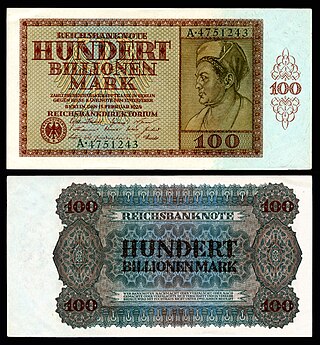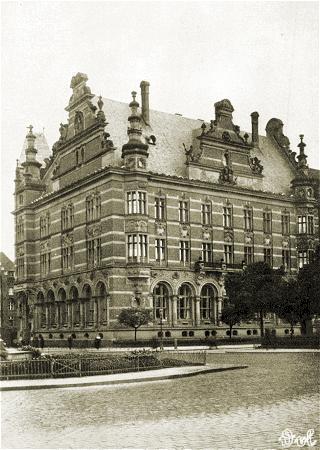
The Deutsche Mark, abbreviated "DM" or "D-Mark" ( ), was the official currency of West Germany from 1948 until 1990 and later the unified Germany from 1990 until the adoption of the euro in 2002. In English, it was typically called the "Deutschmark". One Deutsche Mark was divided into 100 pfennigs.

The schilling was the currency of Austria from 1925 to 1938 and from 1945 to 1999, and the circulating currency until 2002. The euro was introduced at a fixed parity of €1 = 13.7603 schilling to replace it. The schilling was divided into 100 groschen.

The pfennig ; symbol pf or ₰) or penny is a former German coin or note, which was the official currency from the 9th century until the introduction of the euro in 2002. While a valuable coin during the Middle Ages, it lost its value through the years and was the minor coin of the Mark currencies in the German Reich, West Germany and East Germany, and the reunified Germany until the introduction of the euro. Pfennig was also the name of the subunit of the Danzig mark (1922–1923) and the Danzig gulden (1923–1939) in the Free City of Danzig.

The Reichsmark was the currency of Germany from 1924 until the fall of Nazi Germany in 1945, and in the American, British and French occupied zones of Germany, until 20 June 1948. The Reichsmark was then replaced by the Deutsche Mark, to become the currency of West Germany and then all of Germany after the 1990 reunification. The Reichsmark was used in the Soviet occupation zone of Germany until 23 June 1948, where it was replaced by the East German mark. The Reichsmark was subdivided into 100 Reichspfennig. The Mark is an ancient Germanic weight measure, traditionally a half pound, later used for several coins; Reich comes from the official name for the German state from 1871 to 1945, Deutsches Reich.

The Papiermark was the German currency from 4 August 1914 when the link between the Goldmark and gold was abandoned, due to the outbreak of World War I. In particular, the Papiermark was the currency issued during the hyperinflation in Germany of 1922 and 1923.

The krone was the official currency of Austria-Hungary from 1892 until the dissolution of the empire in 1918. The subunit was one hundredth of the main unit, and was called a Heller in the Austrian and a fillér in the Hungarian part of the Empire.

The Rentenmark was a currency issued on 15 November 1923 to stop the hyperinflation of 1922 and 1923 in Weimar Germany, after the previously used "paper" Mark had become almost worthless. It was subdivided into 100 Rentenpfennig and was replaced in 1924 by the Reichsmark.

The German mark was the currency of the German Empire, which spanned from 1871 to 1918. The mark was paired with the minor unit of the pfennig (₰); 100 pfennigs were equivalent to 1 mark. The mark was on the gold standard from 1871 to 1914, but like most nations during World War I, the German Empire removed the gold backing in August 1914, and gold coins ceased to circulate.
Each "article" in this category is a collection of entries about several stamp issuers, presented in alphabetical order. The entries are formulated on the micro model and so provide summary information about all known issuers.

The Austro-Hungarian gulden was the currency of the lands of the House of Habsburg between 1754 and 1892, when it was replaced by the Austro-Hungarian krone as part of the introduction of the gold standard. In Austria, the gulden was initially divided into 60 kreuzers. The currency was decimalized in 1857, using the same names for the unit and subunit.
The Reich Ministry of Armaments and War Production was established on March 17, 1940, in Nazi Germany. Its official name before September 2, 1943, was the 'Reichsministerium für Bewaffnung und Munition'.
Lodz Ghetto mark was a surrogate currency that circulated in the Lodz Ghetto in 1940—1944 until the Ghetto was liquidated in August 1944. It was divided into 100 pfennig. The notes had no value outside the Ghetto, and could not be exchanged into other currencies.

The Flag of the German Empire, or Imperial Flag, Realm Flag, is a combination between the flag of Prussia and the flag of the Hanseatic League. Starting as the national flag of the North German Confederation, it would go on to be commonly used officially and unofficially under the nation-state of the German Reich, which existed from 1871 to 1945.

On the founding of the German Empire in 1871, trade and transport was hampered by the existence of eight different currency systems across the various member states of the Empire. There were eight state currencies whose coins included the Thaler, Vereinsthaler, Konventionsthaler, Kreuzer, Heller, Groschen, Silbergroschen, Neugroschen, Gulden, Konventionsgulden, Schilling, Mark, Pfennig, Neu-Pfennig, Franc, Centime, Bremen Goldthaler, Groten, Schwaren, Prussian or Graumann Reichsthaler, Kurantthaler and Friedrich d'Or, which were all based on different gold and silver standards, making trade more difficult.

The Bank of Danzig was the central bank of the Free City of Danzig, established in 1924 and liquidated in the aftermath of the Danzig crisis in 1939.


































